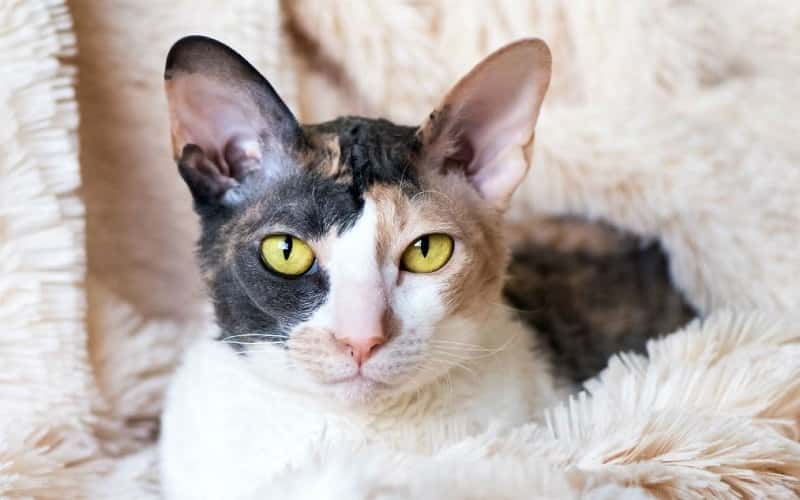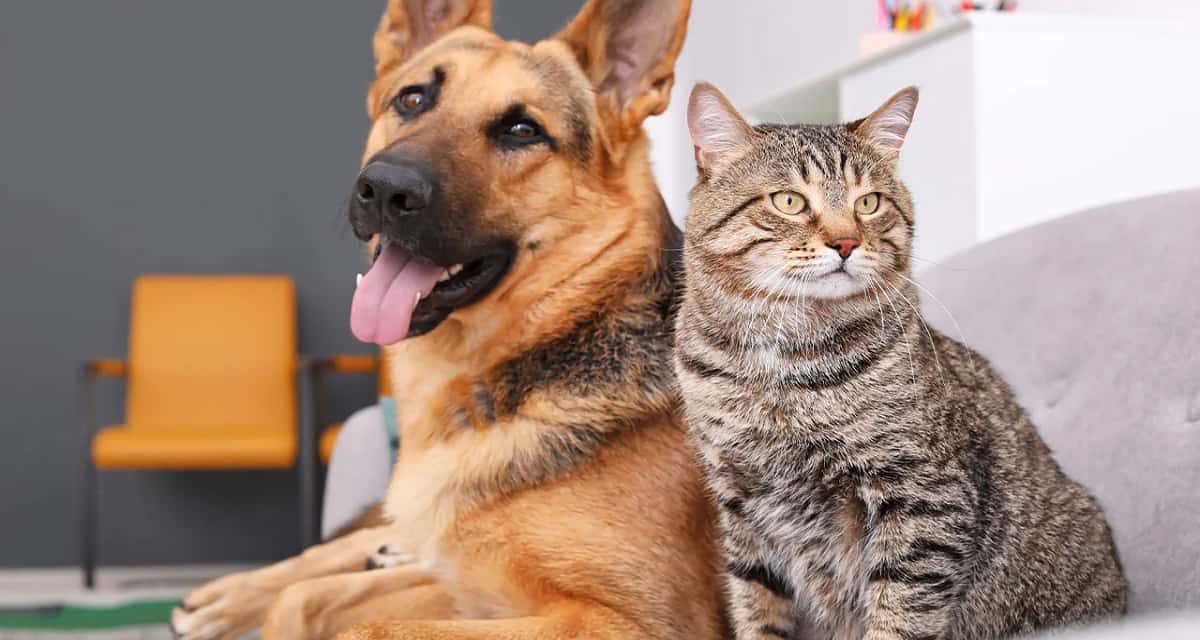Cornish Rex – Mixed Cat Breed Characteristics & Facts

Given that the Cornish Rex is a willing retriever of toys thrown at him, it might be appropriate to refer to him as “doglike” if it weren’t offensive.
The traits of Cornish Rex cats are listed below.
Cornish Rex Mixed Cat Breed Picture




Cornish Rex – Mixed Cat Breed Characteristics
Affectionate with Family | ***** |
Amount of Shedding | ** |
General Health | *** |
Potential for Playfulness | ***** |
Tendency to Vocalize | ** |
Kid-Friendly | ***** |
Friendly Toward Strangers | ***** |
Easy to Groom | ***** |
Intelligence | **** |
Pet Friendly | ***** |
Vital Stats:
| Life span: | 11 to 15 years |
| Length: | Small |
| Weight: | 6 to 10 pounds |
| Origin: | United Kingdom |
History
Cornwall is a kind of enchanted region of the United Kingdom. King Arthur was born there, and the curly-coated Cornish Rex cat breed, one of the most unique and fascinating cat breeds in existence, was also born there. Serena, a tortoiseshell and white shorthaired pet cat that belonged to Nina Ennismore and Winifred Macalister, gave birth to a curly-coated kitten in 1950.
Kallibunker, as he was called, stood out for having an unusual coat that was the result of a spontaneous natural mutation because the other four kittens in the litter had short hair. The father of the litter was unknown, as is so often the case, but Ginger, a shorthaired red tabby who was Serena’s litter brother, was widely believed to be the father.
Ennismore made an effort to produce more of the kittens by breeding them to one another and outcrossing to shorthaired cats after seeking advice on how to establish the new trait. She had some success, breeding animals like Poldhu, a cat, and LaMorna Cove, his offspring. Together, they helped shape the Cornish Rex breed, so named for its birthplace and its textured coat, which is similar to that of rex rabbits.
LaMorna Cove had been exported to the US, and her offspring, who were born from a breeding with Poldhu before she crossed the pond, assisted in establishing the breed there. The U.S. cats were outcrossed to Siamese due to a lack of breeding stock. In 1960, Sham Pain Chas, a son of Poldhu, fathered a litter in Great Britain, preserving the breed there.
The birth of two curly-coated kittens in East Germany, which were found to have a similar mutation that was compatible with the Cornish Rex, also helped the species survive. The Cornish Rex was granted recognition by the American Cat Fanciers Association, the Canadian Cat Association, and the Cat Fanciers Association in 1963 and 1964, respectively. All cat registries now acknowledge the breed.
Size
The average weight of a Cornish Rex is 6 to 10 pounds.
Personality
The Cornish Rex first presents himself as sophisticated and suave, but as soon as he enters the stage, his sense of humor and love of attention take over. He is then prepared to play the piano, perform tricks, or astound onlookers with his ability to leap to the highest point in the room. He can manipulate objects deftly and open doors and cabinets with ease thanks to his long toes.
Anything you don’t want him to have should be safely stored; don’t let him see you doing it. This cat is outgoing and loves people. It will follow them around and wait for any chance to cuddle up or kiss them. Since he enjoys being handled, visiting the vet or training him for therapy work is simple. It might be appropriate to refer to the Cornish Rex as “doglike” if it weren’t offensive. That also applies to his readiness to grab toys that are thrown.
He is as quick as a sighthound, but he lacks the calm demeanor of the sighthound. The Cornish Rex is extremely active and constantly moving. His quick starts and cornering prowess make him look like a finely tuned racecar, as do his speed and sleek exterior. Despite being gentle and affectionate, he is not the right choice for someone looking for a cat that will be quiet and ornamental.
Although he is not as talkative as his Siamese ancestor, his voice can range from sweet to strident, and he will engage in conversation if he feels the need to voice his opinion. Long after it becomes an old dinosaur, the Cornish Rex still acts like a kitten. He is best suited to a home where he will experience the love and ongoing company he longs for. He never loses the desire to interact with people.
Health
Pedigreed and mixed-breed cats both have varying rates of health issues that could be genetic in origin. Although Cornish Rex are typically in good health, the following ailments have been reported in the breed:
- Hereditary baldness, also known as congenital hypotrichosis, is most likely caused by an inherited recessive gene. The Cornish Rex has a very fine coat by nature, but individuals who have less hair than is typical for the breed are thought to be hypotricotic.
- A defect in the abdominal wall near the umbilicus, where it gets its name, causes an umbilical hernia, which causes a portion of the intestine or other abdominal organs to protrude through the abdominal wall. Umbilical hernias in the breed were last documented in a 1997 report. There are additional non-genetic causes for umbilical hernias.
- Some cat breeds, like the Maine Coon, are predisposed to a form of inherited heart disease known as hypertrophic cardiomyopathy. In the Cornish Rex, heritability has not been established.
Care
The Cornish Rex is typically easy to groom—just run your hand through his fur. However, some Cornish Rex cats have longer or woollier coats, so they might benefit from using a fine-tooth comb or a soft bristle brush to keep their fur looking tidy. Gently groom to prevent breaking the fine hairs. The best feature of a Cornish Rex coat is how barely perceptible the hairs are on clothing and furnishings.
Unless the cat is white or has a lot of white on its coat, baths are rarely necessary. If those cats aren’t regularly bathed, they may start to look dirty. To prevent periodontal disease, brush your teeth. Although daily brushing is preferred, once a week is still preferable to never. To get rid of any discharge, wipe the corners of your eyes every day with a soft, damp cloth.
To prevent the spread of any infection, use a different area of the cloth for each eye. Each week, check your ears. If they appear to be dirty, clean them with a cotton ball or soft, damp cloth dipped in a 50/50 solution of warm water and cider vinegar. Cotton swabs shouldn’t be used because they can harm the ear’s interior. Maintain a spotless litter box. Cornish Rex cats, like all cats, are very particular about bathroom cleanliness.
Although the Cornish Rex is warm to the touch, he is constantly looking for warmth. He is likely cold if you are. Purchase him a sweater or two to help him keep warm. A Cornish Rex should only be allowed indoors to avoid contracting illnesses from other cats, getting mauled by dogs or coyotes, and other risks that outdoor cats face, like getting hit by a car. Outdoor-going Cornish Rex also run the risk of being taken by someone who wants to keep such a unique cat without having to pay for it.
If at all possible, construct a sizable outdoor enclosure for your Cornish Rex so that he can jump and climb securely. Apply cat-safe sunscreen to your Cornish REx’s body to prevent sunburn if his outdoor enclosure allows for sunbathing.
Coat Design and Maintenance
The Cornish Rex is a dapper cat with his crushed velvet coat, racy, slender body, and curly whiskers. He is distinguished by a small, egg-shaped head that is about one-third longer than it is wide, in addition to his soft, wavy fur and curved body. His face has a rounded forehead, supermodel-like high cheekbones, a Roman nose with a high, prominent bridge, and oval eyes with a slight upward slant.
Large ears that appear to be capable of receiving satellite signals are perched high on the head. The Cornish Rex’s Siamese ancestors gave him a distinctive body with graceful curves and arches. It has a deep chest, a naturally arched back, a long, slender torso, and a belly that gently curves upward to form a narrow waistline.
The Cornish Rex’s large leaps are propelled by its muscular hips, thighs, and back. Long, slender legs and dainty, slightly oval paws support him when he lands. The end of the long, flexible tail taper. The medium-sized Cornish Rex may appear fragile due to his curved, slender body, but he is surprisingly heavy when picked up. He usually weighs between 6 and 10 pounds.
At birth, the Cornish Rex curls are already present. Some kittens go through a stage where their coats are flat and suede-like; however, as they grow older, their coats return to being wavy. Adulthood, which typically occurs between the ages of 18 months and three years, is marked by a short, silky coat devoid of coarse guard hairs. The fur is curled up close to the body in tight waves, resembling a 1940s movie star’s marcelled hairstyle.
It shouldn’t be too bare or sparse in some areas. The coat is available in a wide variety of hues and designs. White, black, blue, red, cream, chocolate, and lavender are examples of solid colors. Additionally, they come in a variety of tabby hues and patterns, including pointed, tortoiseshell, calico, and bi-color. The eyes can be gold, green, or hazel depending on the color of the coat.
Kids and other animals
For households with young children and canines who get along with cats, the energetic and sociable Cornish Rex is ideal. He can play fetch just as well as any retriever, picks up new tricks quickly, and enjoys the attention from kids who are kind to him. To ensure that they learn to get along with one another, introduce pets gradually and under controlled conditions.
Creator: PetsCareTip







